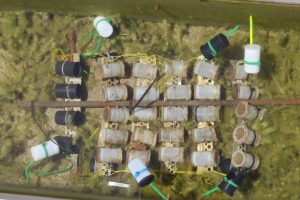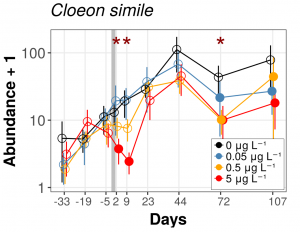In this post, Matthias Wieczorek talks about their recently published paper “Structural and functional effects of a short-term pyrethroid pulse exposure on invertebrates in outdoor stream mesocosms”.
Heavy rainfall may trigger transport of pesticides from agricultural areas to adjacent streams. Especially for sorptive insecticides such as pyrethroids this frequently results in short pulse exposures in river systems. Due to the fast mode of action and the rapid uptake of pyrethroids by aquatic organisms, pulse exposures of few hours can adversely affect invertebrate populations and communities. For example, such pulse exposures may induce catastrophic drift of distinct invertebrate populations and cause mortality (structural effects). Moreover, ecosystem functions such as leaf breakdown, which are the basis of food webs, may be adversely affected subsequent to pyrethroid exposure (functional effects).
In order to assess insecticide-induced effects, aquatic risk assessment mostly uses artificial laboratory systems (tier 1) but may also use more complex mesocosm test systems (higher tier). Recent research has demonstrated that for insecticides the majority of tier 1 threshold concentrations were lower (and thus more conservative) than those derived from higher-tier micro- and mesocosm studies. Hence, the present study using 45-m outdoor stream mesocosms evaluates if the same holds true using a pulse exposure scenario typical for streams and the model pyrethroid insecticide etofenprox. A 6-h pulse exposure with three different concentrations was used. We considered abundance, drift and emergence of invertebrates as structural endpoints and the in situ-measured feeding rates of the isopod leaf-shredder Asellus aquaticus as functional endpoint.
Although the most prominent effects on invertebrate populations and the communities were visible at relatively high etofenprox concentrations, effects could also be determined at an environmentally relevant concentration, which was as low as 0.04 µg/L. This etofenprox concentration, which corresponds well to the tier 1 threshold, reduced both the abundance of the mayfly Cloeon simile by 66% and the feeding rate of A. aquaticus by 44%. Thus, implications for the functional endpoint leaf litter breakdown in heterotrophic ecosystems may be expected. Overall, we could thus demonstrate that the present mesocosm study did not result in a higher threshold concentration compared to tier 1.
The paper authored by Matthias Wieczorek, Nikita Bakanov, Daniel Bilancia, Eduard Szöcs, Sebastian Stehle, Mirco Bundschuh and Ralf Schulz was published in Science of the Total Environment.
You may also be interested in:
Ecotox Facilities III: Landau Stream Mesocosm Facility
Impact of repeated pulse exposures on damselfly larvae


